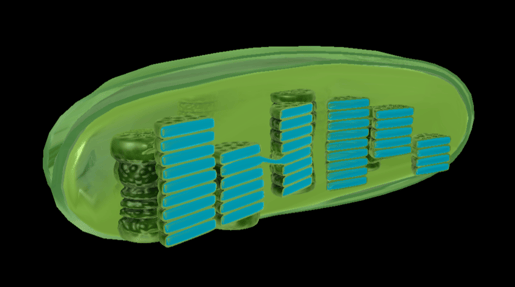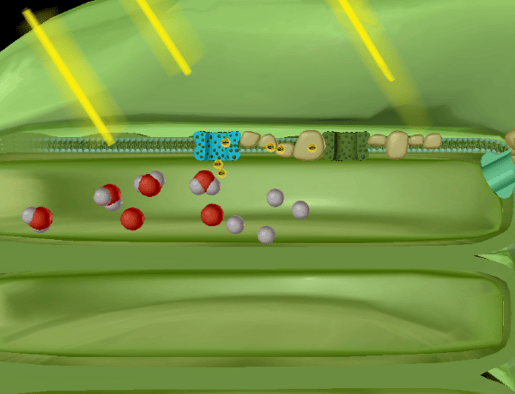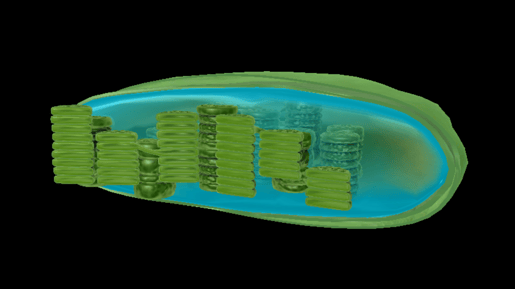A Look Inside the Chloroplast: Organelle Components and Photosynthesis Basics
Posted on 3/18/22 by Sarah Boudreau
Open up your refrigerator—all the delicious things you see in there have either relied on photosynthesis or have eaten something that relies on photosynthesis. During photosynthesis, photosynthetic organisms synthesize sugar molecules from sunlight, water, and carbon dioxide. Photosynthesis takes place in the chloroplasts of plant cells, so they’re the reason that plants (and some other organisms) can produce food on their own
Photosynthesis is important not only for individual organisms, it’s important for life on earth. Photosynthesis is part of the global carbon cycle: put simply, photosynthesis turns carbon dioxide into organic molecules, and respiration turns those molecules back into carbon dioxide.
Shoutout to the chloroplast for making much of this happen! In today’s blog post, let’s explore the chloroplast and the process of photosynthesis.
What is a chloroplast?
The chloroplast is a type of plastid; plastids are organelles with double membranes that are involved with the synthesis and storage of food. Other plastids include chromoplasts (which contain pigments other than green) and leucoplasts (which contain no pigments).
Chloroplasts are filled with chlorophyll, that great green pigment that stains the knees of your jeans if you trip and fall on your lawn. Most algae, and a group of protists called Euglena, also have chloroplasts, and some bacteria (like cyanobacteria) have chlorophyll, but it’s not located in organelles.
The chlorophyll in plants absorbs blue and red light and reflects green. The two most common types of chlorophyll are a and b. Chlorophyll a is in all chloroplasts, and the amount of other chlorophyll types is different depending on the species of plant.
.png?width=515&name=1.2_ccexpress%20(1).png)
Image from VB Suite.
Interestingly, chloroplasts have their own DNA. This is likely because, like mitochondria, they once existed separately from the cell. Chloroplasts were most likely prokaryotic cells that were encompassed by larger eukaryotic cells and evolved into organelles. It’s not a coincidence that chloroplast DNA is small and circular, like bacterial DNA.
There are many chloroplasts throughout the cytoplasm of photosynthetic cells: these cells can have anywhere from one to one hundred chloroplasts that divide to replicate themselves.
Parts of the chloroplast
The chloroplast has three membrane systems: the outer membrane, the inner membrane, and the thylakoid system.
Thylakoids are disc-shaped and collect photons from a light source (usually the sun). They consist of a thylakoid membrane that surrounds the lumen. The lumen is where processes like oxygen evolution, plastocyanin-mediated electron transfer, and photoprotection occur during photosynthesis. Proteins in the lumen contribute to many other processes, including turnover of photosynthetic protein complexes. Thylakoids are arranged in stacks called grana (singular granum).

The lumen (highlighted in blue). Image from VB Suite.
Between the inner membrane and the grana lies the stroma, a thick, protein-rich fluid. This is where the light-independent reactions of photosynthesis take place—but we’ll hear more about that soon!
The basics of photosynthesis
In brief, photosynthesis requires carbon dioxide, water, and sunlight and produces glucose and oxygen.
Learn more about what goes in and what comes out of photosynthesis with this Visible Biology Bite.
The process of photosynthesis has two main kinds of reactions: light-dependent reactions and light-independent reactions. Light-dependent reactions convert light into stored energy, and light-independent reactions use that energy to assemble glucose.
We’ll give you the run-down on both of these categories.
Light-dependent reactions
Light-dependent reactions take place in the thylakoid membrane. In these reactions, the organism absorbs sunlight, breaks down water molecules, puts together ATP and NADPH molecules to store energy, and releases oxygen.
Sunlight hits the chlorophyll within the thylakoid membrane, causing an electron to become excited and leave the chlorophyll molecule. When the electron leaves, it creates a vacuum in its wake. Photosystem II then splits a water molecule to restore the electron. Photosystems are complexes of proteins and pigments— we’ll hear about photosystem I soon.

Photosystem II (highlighted in blue), water molecules being broken down, and electrons moving along to photosystem I. Image from VB Suite.
Once the water molecule has been broken down, it contributes to the building of ATP: its hydrogen ions help the ATP synthase enzyme add a phosphate group to ADP. The leftover oxygen atom combines with another oxygen atom to form O₂, and the oxygen gas is released through openings in the leaves.
Remember that electron that left the chlorophyll molecule? It moves along the thylakoid membrane until it reaches photosystem I. It combines with another excited electron, and an enzyme adds that plus a hydrogen atom to NADP to create NADPH, a molecule that stores energy.
Ta da! Light-dependent reactions convert energy from sunlight into chemical energy.
Light-independent reactions (aka the Calvin cycle)
Light-independent reactions, on the other hand, don’t need light directly. Also called the Calvin cycle, light-independent reactions use the stored energy from the light-dependent reactions to alter the carbon from carbon dioxide so it can be used to build carbohydrates like glucose. These reactions take place in the stroma.

Stroma highlighted in blue. Image from VB Suite.
During light-independent reactions, an enzyme combines a molecule of carbon dioxide with a molecule called ribulose biphosphate (RuBP). The resulting 6-carbon molecule is broken down into two 3-carbon molecules. Then, each of those 3-carbon molecules (called 3-phosphoglycerate or 3-PGA) is given a hydrogen atom, creating glyceraldehyde-3-phosphate, aka G3P.
G3P can be used to build sugars—combine two molecules of G3P and what do you get? Glucose!
The Calvin cycle produces twelve G3P molecules: two of those are used for glucose and the other ten are recycled into RuBP. Then the cycle can continue, creating more and more glucose.
Plants use glucose in many different ways. First and foremost, it’s a source of energy. It’s also used to make cellulose, the primary building material of plants. Glucose can also attach to proteins and lipids to make them more soluble.
Conclusion
The chloroplast is a plastid that is made up of an outer membrane, an inner membrane, grana, and the stroma. It’s within the chloroplast that photosynthesis takes place in plants, turning sunlight and carbon dioxide into sugar and oxygen. The chloroplast and the chlorophyll within it are the reason plants can make their own energy without having to consume other organisms.
If you’re looking for a way to teach photosynthesis, check out this free photosynthesis lesson plan.
If you’re interested in learning more about photosynthesis and how it differs from cellular respiration, check out this blog post!
Be sure to subscribe to the Visible Body Blog for more anatomy awesomeness!
Are you an instructor? We have award-winning 3D products and resources for your anatomy and physiology course! Learn more here.



